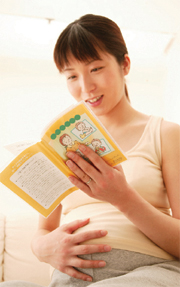As you probably know, reading is an important skill your child will need as she grows up.
How fluently she reads will also help to determine how well she communicates, understands and learns. Instead of waiting until she goes to pre-school, why not give her a head start in reading?
She may not understand at first, but if you spend time with her having fun with words, she’ll grow up loving to read!
Did you know?
Although reading is usually thought of as a visual activity, all of your child’s senses are involved in learning this skill.
|
Ear |
|
|
Hand |
|
|
Nose |
|
|
Tougue |
|
|
Activity:Say after me |
What you need:An alphabet book or chart(you can make a simple one using colourful markers and paper)
What to do:Say the name of each letter as you point to it. Show her pictures or objects with names beginning with each letter. As she grows older, get her to repeat after you and form simple sentences using words beginning with each letter.
|
Activity:Sing with me |
What you need:Nursery rhymes/songs for children
What to do:Read the rhyme or song aloud, clapping along with the rhythm. Then, if you can, sing and ask your child to join in. Songs like the “ABC song” and “1, 2, 3, 4, 5, Once I Caught A Fish Alive” can also help her remember her alphabet and counting basics.
|
Activity:Blind man’s words |
What you need:Large capital letters (about 4” high each) cut out of coarse sandpaper; towel or cloth to use as blindfold
What to do:Blindfold your child (if she is comfortable with it) and lay a few letters in front of her, spelling a word she knows. Time how long she takes to “read” the word with her fingers. Take turns with her and your spouse or other family members. After 5 rounds, add up your times – the winner gets to choose a treat for all of you to enjoy together!
|
Activity:Read a recipe |
What you need:A simple recipe that your child can prepare, with your supervision
What to do:Read the recipe together. For younger children, you may have to read some of the instructions, then explain each action. If you’ve had your child help in the kitchen from a young age, this won’t be necessary. Emphasise the action words like “break”, “whisk”, “stir”, etc.
For older children who may get bored, ask them to make up a story about what they’re making. For example, a bowlful of flour might be a sandy hillside that a magical giant bird drops an egg into, followed by a torrent of cocoa powder rain. Stretch your imagination and let your child’s run wild.
|
Let them see you read |
|
Children love to emulate their parents. Read the papers daily, and set aside some “book time” on weekends by providing reading material appropriate for every family member’s age and interests. Discuss the books that your child is reading and find out why she likes them. By showing her that you’re interested in her interests, you’re indirectly showing her that you’re concerned for her. |










Comments